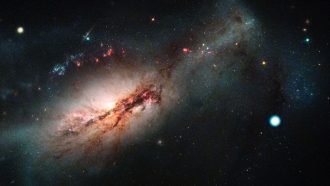
A long-predicted type of cosmic explosion has finally burst onto the scene.
Researchers have found convincing evidence for an electron-capture supernova, a stellar explosion ignited when atomic nuclei sop up electrons within a star’s core. The phenomenon was first predicted in 1980, but scientists have never been sure that they have seen one. A flare that appeared in the sky in 2018, called supernova 2018zd, matches several expected hallmarks of the blasts, scientists report June 28 in Nature Astronomy.
“These have been theorized for so long, and it’s really nice that we’ve actually seen one now,” says astrophysicist Carolyn Doherty of Konkoly Observatory in Budapest, who was not involved with the research.
Electron-capture supernovas result from stars that sit right on the precipice of exploding. Stars with more than about 10 times the sun’s mass go supernova after nuclear fusion reactions within the core cease, and the star can no longer support itself against gravity. The core collapses inward and then rebounds, causing the star’s outer layers to explode outward (SN: 2/8/17). Smaller stars, with less than about eight solar masses, are able to resist collapse, instead forming a dense object called a white dwarf (SN: 6/30/21). But between about eight and 10 solar masses, there’s a poorly understood middle ground for stars. For some stars that fall in that range, scientists have long suspected that electron-capture supernovas should occur.
During this type of explosion, neon and magnesium nuclei within a star’s core capture electrons. In this reaction, an electron vanishes as a proton converts to a neutron, and the nucleus morphs into another element. That electron capture spells bad news for the star in its war against gravity because those electrons are helping the star fight collapse.
According to quantum physics, when electrons are packed closely together, they start moving faster. Those zippy electrons exert a pressure that opposes the inward pull of gravity. But if reactions within a star chip away at the number of electrons, that support weakens. If the star’s core gives way — boom — that sets off an electron-capture supernova.
But without an observation of such a blast, it remained theoretical. “The big question here was, ‘Does this kind of supernova even exist?’” says astrophysicist Daichi Hiramatsu of the University of California, Santa Barbara and Las Cumbres Observatory in Goleta, Calif. Potential electron-capture supernovas have been reported before, but the evidence wasn’t definitive.
So Hiramatsu and colleagues created a list of six criteria that an electron-capture supernova should meet. For example, the explosions should be less energetic, and should forge different varieties of chemical elements, than more typical supernovas. Supernova 2018zd checked all the boxes.
A stroke of luck helped the team clinch the case. Most of the time, when scientists spot a supernova, they have little information about the star that produced it — by time they see the explosion, the star has already been blown to bits. But in this case, the star showed up in previous images taken by NASA’s Hubble Space Telescope and Spitzer Space Telescope. Its properties matched those expected for the type of star that would produce an electron-capture supernova.
“All together, it really is very promising,” says astrophysicist Pilar Gil-Pons of Universitat Politècnica de Catalunya in Barcelona. Reading the researchers’ results, she says, “I got pretty excited, especially about the identification of the progenitor.”
Finding more of these supernovas could help unveil their progenitors, misfit stars in that odd mass middle ground. It could also help scientists better nail down the divide between stars that will and won’t explode. And the observations could reveal how often these unusual supernovas occur, an important bit of information for better understanding how supernovas seed the cosmos with chemical elements.


